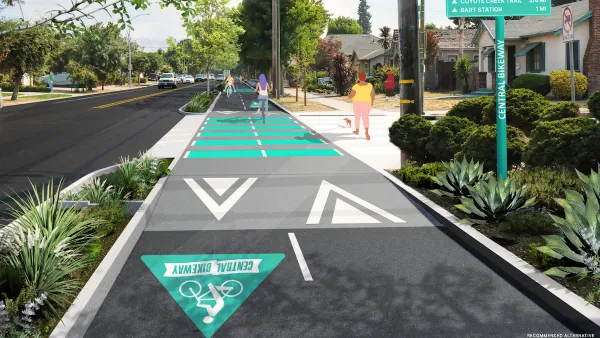No-cost land transfers of underused transportation assets to develop transit-oriented affordable housing could be a game changer for local governments.

Under new guidance from the US Department of Transportation, localities can use assets like land and buildings acquired or improved with federal transit funds to support development of affordable housing, report Jorge González-Hermoso and Yonah Freemark of the Urban Institute.
The new guidelines, called Interim Asset Disposition Guidance, released in October, could help boost housing construction near transit, which has slowed because of increasing development costs and a slow return of transit ridership after the pandemic.
Qualifying transportation assets that are no longer needed for the original purchase can be transferred to local governments, nonprofit organizations, or third-party entities at no cost as long as the properties are used for transit-oriented developments where at least 40 percent of housing units are reserved for low or very low income households. This has huge implications for viability of such projects, as previously transit agencies had to pay back the federal monetary contribution when seeking to transfer assets to other entities.
The Urban Institute speculates a significant portion of available unused land holdings were likely used for construction staging near large projects like rail routes, elevated lines, or subways. As such, they offer several recommendations to ensure state and local governments can take full advantage of these new rules to both increase affordable housing and transit ridership.
Those tips include ensuring zoning policies on land adjacent to stations align with the goal of maximizing density on those sites, focusing affordable housing subsidies on projects that are located on underused, transit-adjacent sites, and planning for property disposition at the start of any new transit project to ensure planning for residential investments can begin as soon as possible.
FULL STORY: Leveraging Underused Transit Properties Could Produce More Affordable Housing

Planetizen Federal Action Tracker
A weekly monitor of how Trump’s orders and actions are impacting planners and planning in America.

Silicon Valley ‘Bike Superhighway’ Awarded $14M State Grant
A Caltrans grant brings the 10-mile Central Bikeway project connecting Santa Clara and East San Jose closer to fruition.

Amtrak Cutting Jobs, Funding to High-Speed Rail
The agency plans to cut 10 percent of its workforce and has confirmed it will not fund new high-speed rail projects.

California Set to Increase Electric Truck Chargers by 25%
The California Transportation Commission approved funding for an additional 500 charging ports for electric trucks along some of the state’s busiest freight corridors.

21 Climate Resilience Projects Cancelled by the EPA
The federal government has pulled funding for at least 21 projects related to farming, food systems, and environmental justice to comply with one of Trump’s early executive orders.

Trump Executive Order on Homelessness Calls for Forced Institutionalization
The order seeks to remove legal precedents and consent decrees that prevent cities from moving unhoused people from the street to treatment centers.
Urban Design for Planners 1: Software Tools
This six-course series explores essential urban design concepts using open source software and equips planners with the tools they need to participate fully in the urban design process.
Planning for Universal Design
Learn the tools for implementing Universal Design in planning regulations.
Yukon Government
Caltrans
New Jersey Institute of Technology
Mpact (founded as Rail~Volution)
City of Camden Redevelopment Agency
City of Norman, Oklahoma
City of Portland
City of Laramie





























